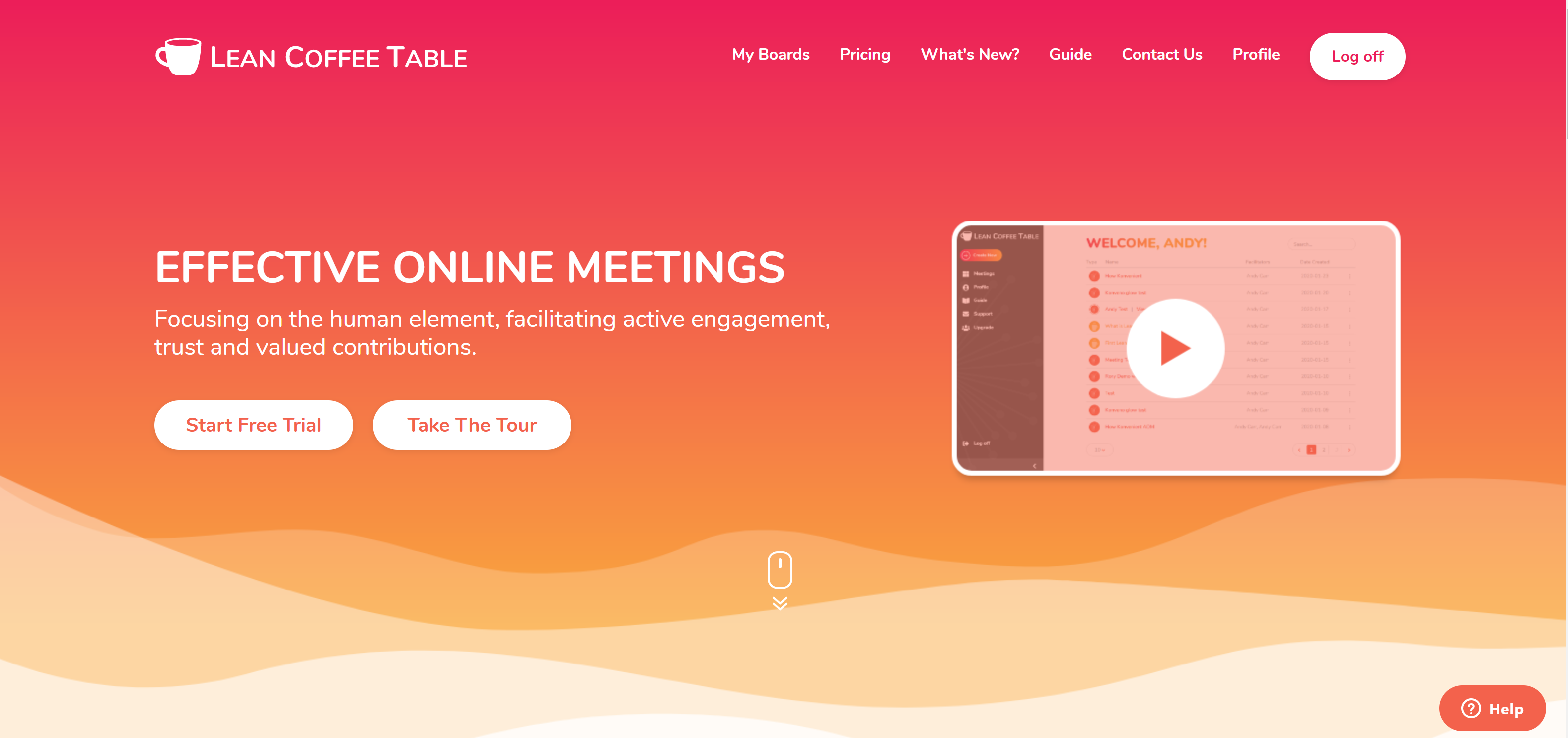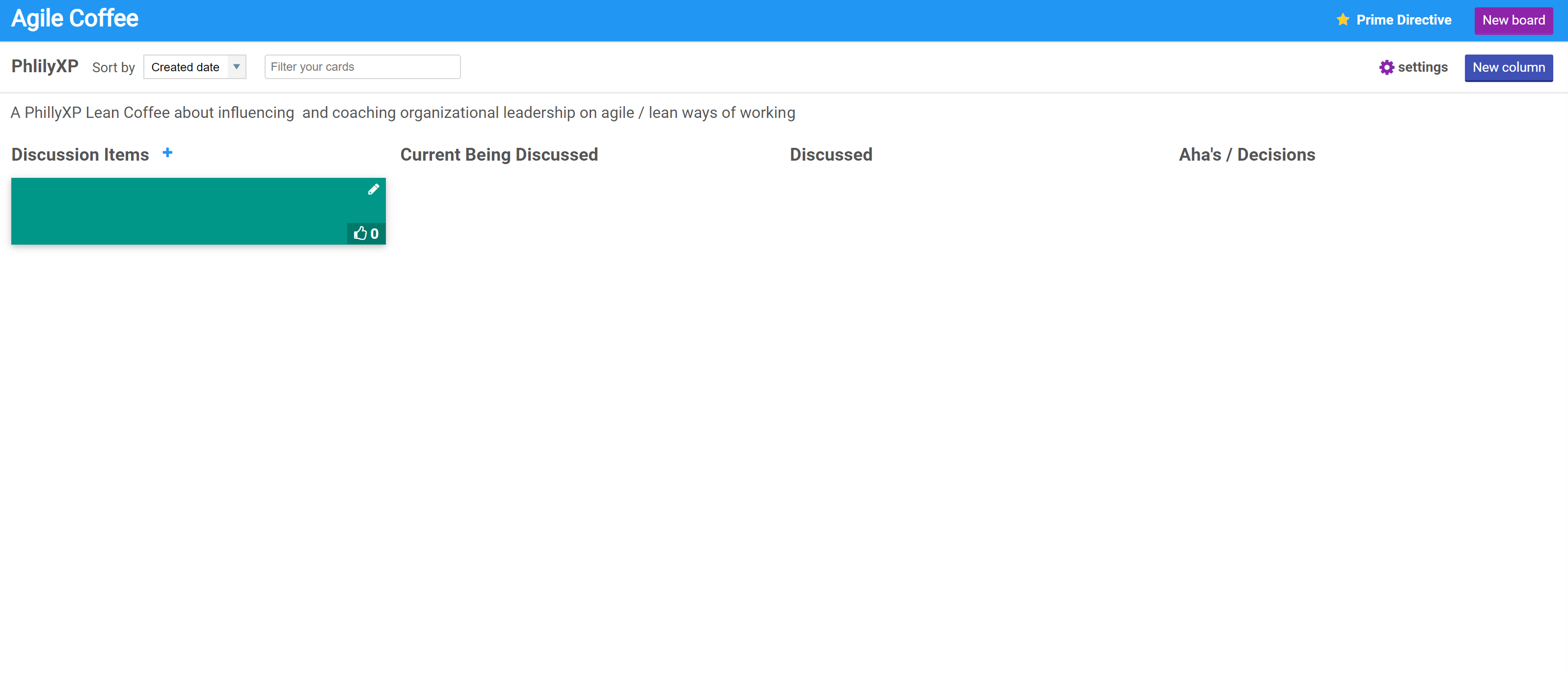Hosting a Virtual Lean Coffee
29 Nov 2020 . coaching . Comments #coaching #retrospectives
Lean Coffee is a fantastic technique to facilitate discussions or meetings. I’ve used it to host company meetings, user group meetings, knowledge sharing sessions, and even as a retrospective format. It is simple to learn, has a lot of benefits over traditional meeting facilitation techniques, and is a lot of fun. At a time when most technology and software companies are working remotely, there are several tools available to help you host a virtual lean coffee.
When I was coaching software development teams with Industrial Logic, we started each day of the coaching Dojo with a Lean Coffee session. It was a great way to share knowledge across teams going through the Dojo experience separately, but also a way to include organizational leadership in conversations.
What is Lean Coffee?
Lean Coffee is a structured, but agenda-less meeting. Participants gather, build an agenda, and begin talking. Conversations are directed and productive because the agenda for the meeting was democratically generated.
—leancoffee.org
Getting Started
Follow these simple steps to host a lean coffee session:
- Break into groups. The smaller the group the more each participant’s topics will be covered. Try to size groups to no more than seven (but feel free to experiment and adjust the size).
- Each group then builds a four-column Kanban board with the columns To Discuss, Discussing, Discussed, and finally one for decisions, actions, and key learnings (I label this last column Aha’s / Decisions).
- (Optional) Focus the group on a specific topic. Otherwise any topic can be covered by the group.
- Participants brainstorm discussion topics for three minutes and write each topic on a separate post-it note.
- Each participant gets about 30 seconds to pitch each topic to their group. It should be no more than a few sentences.
- Everyone dot votes - each person gets a limited (3-5) dots to rank the items they want to talk about. They can use multiple dots on a topic if they wish.
- Decide on the discussion time limit (anywhere between 5 and 15 minutes). I usually use five minutes per topic.
- Place the topics in priority order in the first (To Discuss) column.
- Discuss the highest priority topic as a group with each person taking notes.
- Any key decisions, actions, ideas, or things learned get documented and placed in the last column. I like to use different color post-its for decisions, actions, and things learned.
- When the timer is up everyone thumb votes on whether to continue the conversation (thumbs up), move on to the next topic (thumbs down) or if they don’t feel strongly in either direction (thumbs middle). Middle thumbs are excluded from the voting.
- If the discussion is continued reset the timer for an additional three minutes and repeat the voting when the timer expires.

A Brief History
Lean Coffee was created by Jim Benson and Jeremy Lightsmith in Seattle in 2009. They intended to create a group to meet and discuss lean techniques but didn’t want to create an organization with committees and speakers, they were looking for something much lighter-weight. They wanted a group that did not rely on anything other than people showing up and wanting to learn or create.
Benefits
I use the lean coffee format often. It’s easy to learn and fun, but more importantly, it democratizes conversations. I tend to reach for it when I see power dynamics at play in meetings. If individual contributors and leaders are in the same meeting and I see voices not being heard I’ll plan a lean coffee. Even in groups that don’t have power dynamic issues it generally increases the engagement of all of the participants.
Virtual Lean Coffees
While it’s easier to hold these sessions in person. There is a variety of tools available to help you facilitate a virtual lean coffee.
Tooling
Miro

Miro is one of my favorite collaboration tools, so it is the first one I reach for in virtual collaboration sessions.
Pros
- Many collaborative use cases
- Built-in timer
- Built-in voting
- Flexibility to customize your lean coffee
- Free-tier licensing
- Paid-tiers allow for collaborating on boards without a Miro account
- Ability to export boards/post-its
Cons
- Free-tier license requires every participant to have an account and share all boards in the group
- No Lean Coffee templates currently exist at the time of this writing. Some upfront work to build your board
Lean Coffee Table

Lean Coffee Table is an online tool built specifically for hosting lean coffee sessions.
Pros
- Support for lean coffee and other virtual meetings
- Integrates with Zoom
- Built-in timer
- Built-in voting
Cons
- No free-tier license available
Agile Coffee

Agile Coffee is a tool that is built using the FunRetro virtual retrospective tool. While limited in functionality and not the slickest of the tools, it is a great option if you don’t want to require your attendees to have an account.
Pros
- Free
- No accounts required
- Built in voting
- Customizable columns / column names
- Ability to export boards
Cons
- Lacking in features compared to some of the other options
- No built-in timer
- Cannot control access to the boards
Retrium

Retrium is a virtual retrospective tool that has a Lean Coffee template.
Pros
- Customizable columns
- Built-in dot voting
- Supports grouping notes (i.e., affinity mapping)
Cons
- No free-tier license
Zoom
Zoom is a virtual meeting tool that can be paired with any of the above Lean Coffee tools. I recommend it here specifically because of its breakout room functionality. When you are hosting multiple groups for a virtual lean coffee the breakout room functionality is necessary to allow the groups to work together and then rejoin the larger group to share insights and decisions.
Breakout room features are currently in development for Microsoft Teams, once available that will become a viable alternative to Zoom for hosting Lean Coffee sessions.
When to hold Lean Coffees
There’s no right or wrong answer when trying to determine when to use the Lean Coffee format. If you want to share knowledge, have a brainstorming session, get increased (or more even participation) those are good cases for a Lean Coffee. Add it into your retrospective format rotation, especially if your teams are recycling the same format in every retrospective. Experiment with it and see how it works for you.
Additional Resources
Follow these links for additional information about Lean Coffee: